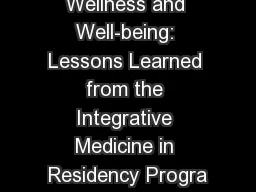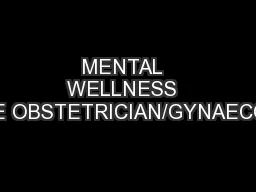PPT-Wellness and Well-Being
Author : sherrill-nordquist | Published Date : 2020-01-02
Wellness and WellBeing Sarah F Spiegelhoff MA EdS NCC sfspiegesyredu Wellness and WellBeing What is wellness Wellness models Wheel of Wellness amp The Indivisible
Presentation Embed Code
Download Presentation
Download Presentation The PPT/PDF document "Wellness and Well-Being" is the property of its rightful owner. Permission is granted to download and print the materials on this website for personal, non-commercial use only, and to display it on your personal computer provided you do not modify the materials and that you retain all copyright notices contained in the materials. By downloading content from our website, you accept the terms of this agreement.
Wellness and Well-Being: Transcript
Download Rules Of Document
"Wellness and Well-Being"The content belongs to its owner. You may download and print it for personal use, without modification, and keep all copyright notices. By downloading, you agree to these terms.
Related Documents














